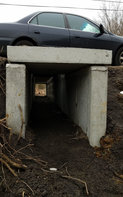 Monmouth County Environmental Newsletter: August 2018
|
|
|
|
Having trouble viewing this email? View it as a Web page.
|
|
|
|
 Monmouth County's First Wildlife Passage System
Left: Under-road tunnel at Assunpink Wildlife Management Area. Source: NJDEP
The New Jersey Division of Fish and Wildlife (NJDFW) is constructing the County’s first wildlife passage system in the Assunpink Wildlife Management Area (WMA), Upper Freehold. The project aims to reconnect habitats fragmented by roads to provide animals with a safe passage between wetlands. It’s part of a statewide effort called Connecting Habitat Across New Jersey (CHANJ). CHANJ projects make roadways and landscapes more conducive to wildlife movement.
The passage system at Assunpink WMA is almost complete. Currently the tunnel is in place and fencing will be installed before the end of the year. Fencing will guide animals to the tunnel, preventing them from crossing the roadway. Over several seasons, the NJDFW has monitored the roads and wildlife and will continue to monitor to determine the project's effectiveness.
For more information click here
|
Opportunity for Municipalities to Enlist Volunteers for Sustainable Jersey Projects
Sustainable Jersey and the Center for Community Engaged Learning and Research (CELR) at The College of New Jersey (TCNJ) are accepting applications to enlist 10-20 TCNJ student volunteers for applicable Green Team projects that contribute to Sustainable Jersey certifications. Local green teams must arrange for all materials and training for the day, TCNJ CELR will provide transportation to site, lunch, and supervision for TCNJ students.
Applications are due by midnight, Sept. 2. Municipalities may submit more than one proposal for projects on different days. Notifications of selected municipalities will be made on a rolling basis. Selection is based on distance to TNCJ campus, scheduling availability and the proposed projects. Applicants should expect to hear back within two weeks of their submission. Click here to learn more. For questions, contact Megan Nicholson at TCNJ.
|
|
Upcoming Environmental & Outdoor Events in Monmouth County:
Some activities require
registration and/or fees:
-
Aug. 3, 6, 10, 13, 17, 10-11:30 a.m. Seining
on the Bay Sandy Hook parking Lot C,
Bayside
-
Aug. 8 & 22 6-8 p.m. Sunset
Seining, ALS Ft. Hancock Building 18 at Sandy Hook
- Aug. 9, 16, 23, 30 11am-12 pm Enviro-Quest, various Monmouth County Parks
- Aug. 14, 1-2 p.m. Sustainable Jersey Maximizing Energy
Efficiency in Your Building Webinar, Online
-
Aug. 16, 6-8 p.m. Bird
Walk, Sandy Hook, parking Lot M
-
Aug. 16, 8-11 p.m., Stars
of Sandy Hook, Lot E Beach Plaza
- Aug. 18-19, 12-2 pm Potato Harvest at Historic Longstreet Farm
-
Aug. 25, 9 a.m.- 12 p.m. Shore Birds & Wild Edibles,
Parking Lot M at Sandy Hook
- August Weekends, Wednesdays, and Holidays, Drop-In Eco-Boat Tours, Manasquan Reservoir Visitor Center
- Sept. 6, 5-7 p.m. Monmouth County Environmental Council Meeting, Hall of Records Annex, 2nd Floor, Freehold
|
|
|
Division of Planning Welcomes New Environmental Specialist
 Amber Mallm joined the Monmouth County Division of Planning this July as an Environmental Specialist. During her first few months with the Division's Environmental and Sustainability Planning section, she will focus on completing the County's Wastewater Management Plan and the Natural Resource Inventory, performing environmental reviews, staffing the Monmouth County Environmental Council, and other duties. She is very excited for the beginning of this major point in her career.
Amber first joined the Division in September 2017 as the Monmouth Coastal Watersheds AmeriCorps Ambassador. This program is hosted by NJDEP, which stations one ambassador in each of NJ’s 20 Watershed Management Areas. As Watershed Ambassador, Amber completed 10 projects with various partners in the County, 66 presentations at local schools and public events and 35 field studies. During her time as Watershed Ambassador, she collaborated with countless individuals across the County, including the County Environmental Council and Parks System.
Amber has strong roots in the County. She is a County resident and attended local schools. She earned a Bachelor of Science degree at Rutgers University where she studied Environmental Policy, Institutions, and Behavior with a minor in Sustainability. She enjoys going to the beach at Ocean Grove, picking fruit at local orchards, and entering her artwork in the Monmouth County Fair Home and Garden Competition. This Jersey girl feels right at home! Welcome Amber!
|
|
|
|
|
|
|
2018 Horseshoe Crab Monitoring Results
Horseshoe crabs at Keyport Harbor. Source: Carla Mallm
On June 28, the Bayshore Regional Watershed Council
concluded its 10th annual horseshoe crab monitoring study along
Sandy Hook Bay and Raritan Bay. The goal of the study is to determine whether the local spawning population is stable,
increasing or decreasing. On four full moon and high-tide nights this season, volunteers counted horseshoe
crabs simultaneously at five sites: Plum Island at Gateway Sandy
Hook, Many Mind Creek in Atlantic Highlands, Leonardo Beach in Middletown
Township, Keyport Harbor near Chingaroa Creek, and Cliffwood Beach in Aberdeen Township. Each site this season supported crabs.
Results this year are they highest recorded in 10
years of the Council’s monitoring. This season, volunteers counted 6,543 crabs. The
Bayshore Regional Watershed Council’s End-of-Year Report for 2017, shows a total of
2,077 crabs counted in 2017. The highest recorded population was 2,913 crabs in 2013. The significant increase in crab population for 2018 is a good sign
of a recovery in the bay.
|
|
Clinging Jellyfish Sighted in Monmouth County
Clinging Jellyfish compared to a quarter. Source: NJDEP
In July, NJDEP issued an advisory on clinging jellyfish for recreational users in the Shrewsbury and Manasquan Rivers, as well as locations in Ocean County. Clinging jellyfish range from the size of a dime to a size of a quarter and have a distinctive, red, orange, or violet cross across the middle. Its 60-90 tentacles contain stinging cells that can cause muscle cramps, sweating, anxiety, hypertension, heart dilation and other symptoms. NJDEP urges the public to use caution where these jellyfish may be present.
Clinging jellyfish are not typically found at ocean beaches. Instead, they inhabit shallow bays and estuaries and attach themselves to submerged sea grass and algae. People swimming and boating in bays and estuaries should take extra precaution and wear protective boots or waders if walking through submerged vegetation. Click here for more information.
The NJDEP is partnering with Montclair State University to study the species presence in New Jersey. If you see a clinging jellyfish do not capture it, but take a photograph if possible and send it to Dr. Paul Bologna or Joseph Bilinski along with location information. Click here to view a NJDEP Clinging Jellyfish presentation.
|
|
|
Hurricane Activity for 2018
 The Colorado State University Tropical Meteorology Project has been the leading agency for hurricane season predictions for 35 years. Its most recent forecast for Atlantic Basin hurricane activity predicts below average activity, as the Tropical Atlantic and North Atlantic sea surface temperatures are currently cooler than normal.
Regardless of how much activity is predicted, residents should remain vigilant during the peak season and autumn months. Atlantic Basin peak hurricane season is considered mid-August through mid-October, while NJ's peak season ends mid-September. However, about half of the state’s most destructive storms on record occurred later in the season: the Great New Jersey Hurricane of 1903, the Great Atlantic Hurricane of 1944, Hurricane Donna (1960), and Hurricane Floyd (1999) hit the coast in mid-to-late September while the ‘Snow Hurricane of 1804” and Superstorm Sandy (2012) both devastated our shores in October. The final seasonal forecast for the Atlantic Basin will be posted here, August, 2.
|
Proposed Bill S1333: Update to the New Jersey Shore Protection Master Plan
Proposed Senate bill 1333 would require the NJDEP to update the New Jersey Shore Protection Master Plan 24 months after enactment. The current New Jersey Shore Protection Master Plan was published in October 1981. A new plan offers updates to current conditions and shore protection projects in the state.
Under the bill, the plan would include: list of current and on-going projects undertaken by the state and those planned to commence in the next five years; list of project requests by local governments that were previously denied allocations from the Shore Protection Fund; a five-year capital program for beach protection facilities projects and programs; evaluation of land use management alternatives, including acquisition, for risk reduction through NJDEP's planning and implementation of shore protection projects; consideration and prioritization of natural and nature-based approaches; an enforceable plan for the protection, expansion, and enhancement of public access to the the shoreline and public trust lands; and consultation and engagement with experts in coastal zone and shoreline management in the development of the update to the plan.
An identical bill, A1093, passed in the assembly on June, 7. The Senate bill is currently in committee. Click here to read the full proposed Senate bill.
About This Newsletter
The purpose of the newsletter is to inform Monmouth County citizens on the health of their environment and list environmental outreach events in their community. The newsletter is produced by the Monmouth County Division of Planning Section of Environmental & Sustainability Planning in coordination with the Monmouth County Environmental Council. The County of Monmouth and the Board of Chosen Freeholders do not necessarily share the viewpoints of any environmental group mentioned in this newsletter.
If you have questions, comments, or wish to have an event listed in the newsletter, please contact: Amber.Mallm@co.monmouth.nj.us
|
|
|
|